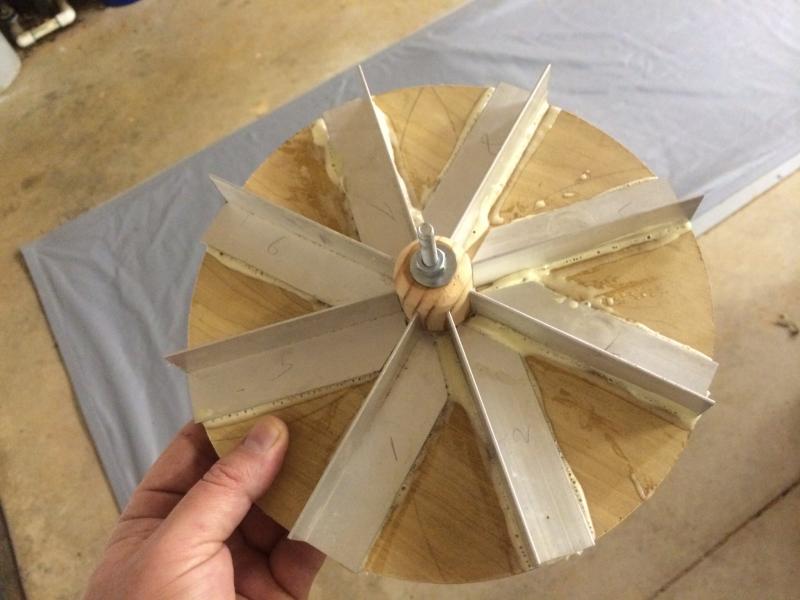If anyone here needs bonded phosphate investment, vinyl polysiloxane duplicating material or smaller than the above mentioned refractory materials shoot me a PM. I get "expired" materials from time to time and trash most of it.
Would love to hear more about the refractory! My homemade stuff has been ok so far (a couple cracks but that isn't a big deal). Next one I build will be with some proper material that I can take up to iron temps without worrying about it. Making good investment casts or duplicating is way beyond my skill level but that it awesome to have a friend in the business now!
Yeah, but it's not memorable. Unlike building a crucible out of a garbage pail. That's pretty cool right there.
That's awesome! Thank you sir.
I did a little more playing with the burner setup and the more a tweak, the more a realize that I need a bigger fan for more air and a better way to control the fuel. If I keep a little burning wood in the bottom as an excitor, the furnace has a rock solid reliable burn and is easy to throttle using the little needle valve I use to control it. But with the wood burned up, I have to keep the temps pretty high to keep reliable (and smoke/smell free) combution. At those flow rates, I'm getting some flame back out of the intake hole which leads me to believe I need more air flow (and more air in general).
I had some old box fan motors so I built a reasonably stout centreugal fan. I uses some thin aluminum angle and a plywood disk to make the rotor. I made the housing with some PVC from a paint bucket and some scrap plywood and it works pretty well but I ran out of day light (read ran out of energy) so I didn't get a chance to plumb it in. I did try to cast the rotor and found my skills lacking as is the ability to cast very thin cross sections. So I might try to remake the rotor with thicker material and try to cast it again. I didn't get good pics of all of this but here is one of the rotor before I cleaned up the gorilla glue squeeze out. I will say I am amazed that the aluminum has stayed glued to the wood.

And for a little fire pron (who doesn't like fire), a little more burner testing...
And this one had the whole inside of the furnace glowing white hot. If color is any indictation, this should have been well into the iron melting range but I didn't stay there very long.
Just a bit of info on crucibles, I've been using soup cans for aluminum but they really are only good for one casting and not safe even then. It's really something how quickly they decompose under the heat and high oxygen levels near the bottom of the furnace. In those conditions, all steel cruicbles basically rust (all rust is, is the oxidation of the iron in the steel) and flake off. Because cans are very thin, this basically kills them and makes them unsafe to transport molten material to your molds. A lot of beginners use steel pipe of some kind and just replace them but after a while, most who keep doing it either make or buy some kind of ceramic crucible. On the buying side, the three common crucible materials are fireclay, clay graphite, and silicon carbide. The fireclay is basically a high quality (by generic ceramics standards) thick clay pot. They cheapest, fails the quickest, and has the lowest temp rating. A fireclay cruicble is fine for aluminum. The clay graphite is just a composite with some content of graphite. These are generally a little more pricey and can handle temps bronze requires. Silicon carbide is much more expensive but can take the heat of iron melting and will last much longer. These are a little beyond the shtf scenario that might have you trying to replace a broken part on X machine so I'm going to do a little experimenting to making some cruicibles and post up the results in the future and use the furnace to fire it. More to come with some actual casting!
Edit: yeah that's really a set of jumper cables running the whole works off my wife's SUV's battery. SHTF might just mean I'm too lazy to build something better so my resources are limited.
Last edited by a moderator:











 No doubt ... very cool thread ... man am I itching for GC to get retired and us get out of town. I think my last "adventure" at Sam's (see CHenry's First Open Carry Comment thread in 2nd A, I think) has finally convinced him ... even though I did get in trouble for not having my gun on me ...
No doubt ... very cool thread ... man am I itching for GC to get retired and us get out of town. I think my last "adventure" at Sam's (see CHenry's First Open Carry Comment thread in 2nd A, I think) has finally convinced him ... even though I did get in trouble for not having my gun on me ...  (Yes, I was a "bad girl" ...)
(Yes, I was a "bad girl" ...)